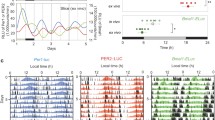Abstract
The circadian behavioral rhythms show seasonal changes not only in animals in the field but also in humans in urban environments. In nocturnal rodents the activity time is compressed or decompressed in response to day lengths. A two-oscillator model has been proposed to explain this photoperiodic response; an evening (E) oscillator is entrained to a dusk signal and drives activity onset, while a morning (M) oscillator is entrained to a dawn signal and controls the end of the active period. However, the location and the oscillation mechanism for these oscillators remain to be elucidated. Recent progress in understanding molecular circadian clock mechanisms and bioluminescent reporters for clock gene expressions enabled us to monitor the E and M clocks’ tick separately. We measured clock gene Per1 expression levels continuously from individual cells as well as tissue explants of the hypothalamic suprachiasmatic nucleus (SCN) using transgenic mice carrying a luciferase reporter gene (Per1-luc mice) which were kept in different photoperiods. We found that there are two regionally specific oscillatory cell groups in the SCN that regulate activity onset and end separately in response to photoperiods, which we assume correspond to E and M oscillators. In addition, a third group of oscillatory cells was identified in the SCN only in a long photoperiod. These oscillatory cell networks change dynamically their clock gene expression pattern depending on environmental lights. Similar mechanisms may underlie seasonal changes in sleep time and melatonin rhythms of humans.
Similar content being viewed by others
References
Gwinner E. Circannual rhythms in birds. Curr. Opin. Neurobiol. 2003; 13: 770–8.
Lincoln GA, Clarke IJ, Hut RA et al. Characterizing a mammalian circannual pacemaker. Science 2006; 314: 1941–4.
Gorman MR, Goldman BD, Zucker I. Mammalian photoperiodism. In: Takahashi JS, Turek FW, Moore RY, eds. Hand Book of Neurobiology 12. Circadian Clocks. Kluwer Academic/Plenum Publisher: New York, 2001; 481–508.
Yoshimura T. Molecular mechanism of the photoperiodic response of gonads in birds and mammals. Comp. Biochem. Physiol. A 2006; 14: 345–50.
Hazlerigg DG, Wagner GC. Seasonal photoperiodism in vertebrates: from coincidence to amplitude. Trends Endocrinol. Metab. 2006; 17: 83–91.
Karsch FJ, Bittman EL, Foster DL et al. Neuroendocrine basis of seasonal reproduction. Recent Prog. Horm. Res. 1984; 40: 185–227.
Pittendrigh C, Daan S. A functional analysis of circadian pacemakers in nocturnal rodents. J. Comp. Physiol. A 2006; 14: 345–50.
Inagaki N, Honma S, Ono D et al. Separate oscillating cell groups in mouse suprachiasmatic nucleus couple photoperiodically to the onset and end of daily activity. Proc. Natl. Acad. Sci. U.S.A. 2007; 104: 7664–9.
Wehr TA, Moul DE, Barbato G et al. Conservation of photoperiod-responsive mechanisms in humans. Am. J. Physiol. 1993; 265: R846–57.
Wehr TA, Giesen HA, Moul DE. Suppression of men’s responses to seasonal changes in day length by modern artificial lighting. Am. J. Physiol. 1995; 269: R173–8.
Honma K, Honma S, Khosaka M et al. Seasonal variation in the human circadian rhythm: dissociation between sleep and temperature rhythm. Am. J. Physiol. 1992; 262: R885–91.
Jagota A, de la Iglesia HO, Schwartz WB. Morning and evening circadian oscillations in the suprachiasmatic nucleus in vitro. Nat. Neurosci. 2000; 4: 372–6.
Reppert SM, Weaver DR. Coordination of circadian timing in mammals. Nature 2002; 418: 935–41.
Messager S, Ross AW, Barrett P et al. Decoding photoperiodic time through Perl and ICER gene amplitude. Proc. Natl. Acad. Sci. U.S.A. 1999; 96: 9938–43.
Nuesslein-Hildesheim B, O’Brien JA, Ebling FJP et al. The circadian cycle of mPER clock gene products in the suprachiasmatic nucleus of the siberian hamster encodes both daily and seasonal time. Eur. J. Neurosci. 2000; 12: 2856–64.
Steinlechner S, Jacobmeier B, Scherbarth F et al. Robust circadian rhythmicity of Per1 and Per2 mutant mice in constant light, and dynamics of Perl and Per2 gene expression under long and short photoperiods. J. Biol. Rhythms 2002; 17: 202–9.
Sumova A, Jac M, Sladek M et al. Clock gene daily profiles and their phase relationship in the rat suprachiasmatic nucleus are affected by photoperiod. J. Biol. Rhythms 2003; 18: 134–44.
Hazlerigg DG, Ebling FJP, Johnston JD. Photoperiod differentially regulates gene expression rhythms in the rostral and caudal SCN. Curr. Biol. 2005; 15: 449–50.
Johnston JD. Measuring seasonal time within the circadian system: regulation of the suprachiasmatic nuclei by photoperiod. J. Neuroendocrinol. 2005; 17: 459–65.
de la Iglesia H, Meyer J, Carpino A Jr, Schwartz WJ. Antiphase oscillation of the left and right suprachiasmatic nuclei. Science 2000; 290: 799–801.
Yan L, Foley NC, Bobula JM et al. Two antiphasic oscillations occur in each suprachiasmatic nucleus of behaviorally split hamsters. J. Neurosci. 2005; 25: 9017–26.
Author information
Authors and Affiliations
Corresponding author
Rights and permissions
About this article
Cite this article
Honma, S., Inagaki, N., Ono, D. et al. Clock mechanisms for seasonal adaptation: Morning and evening oscillators in the suprachiasmatic nucleus. Sleep Biol. Rhythms 6, 84–90 (2008). https://doi.org/10.1111/j.1479-8425.2008.00347.x
Accepted:
Published:
Issue Date:
DOI: https://doi.org/10.1111/j.1479-8425.2008.00347.x




